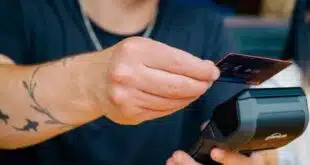Leading online payments provider PayPal Holdings Inc. disclosed late Tuesday that the big department-store chain Macy’s Inc. would accept PayPal not only on its Web sites and on mobile devices but also in its stores. The announcement breathes new life into PayPal’s years-long effort to come to the physical point of sale.
Cincinnati-baed Macy’s operates 885 stores in 45 states, the District of Columbia, Guam, and Puerto Rico under the Macy’s, Bloomingdale’s, Bloomingdale’s Outlet, and Bluemercury monikers.
“Macy’s Inc. is rolling out PayPal as a payment option for its brands in-store, online, and on mobile, and by the end of the month, PayPal will be available as a payment option for all of its customers,” Robert Clarkson, vice president of large enterprise retail sales and partnerships at San Jose, Calif.-based PayPal, wrote in a blog post. “Now, all Macy’s and Bloomingdale’s customers can seamlessly shop and check out across all channels.”
In-store customers can pay via PayPal’s Payment Code technology, which lets a consumer make a purchase by opening the PayPal or Macy’s app on her mobile device and scanning a Quick Response (QR) code on the phone to complete a purchase. Macy’s also will integrate PayPal’s One Touch system for online and mobile purchases. The technology enables customers who opt in to pay without having to type in payment credentials, user names, or passwords.
A Macy’s spokesperson did not respond to a Digital Transactions News request for comment by late Tuesday afternoon.
PayPal started a high-profile effort in 2012 to get to the point of sale. The initiative brought in some prominent retailers, including The Home Depot Inc., Toys ‘R Us, and Foot Locker. PayPal also struck a deal with Discover Financial Services that held the promise of bringing PayPal to potentially millions of small and mid-size merchants.
The effort seemed to slow considerably, however, when it encountered resistance from some of the nation’s largest merchant acquirers, including First Data Corp., which balked at what they perceived as offering a rival payments service to their merchants. That opposition forced PayPal to rethink its strategy.
“PayPal never gave up on its POS initiative,” says analyst Gil Luria, managing director at Los Angeles-based Wedbush Securities. “They had to pause because of resistance from the large-bank merchant acquirers, but have always intended to keep pushing forward.”
PayPal may have found a solution when it bought Auburndale, Mass.-based Paydiant Inc. in April for $230 million. Paydiant provides a white-label mobile-payments platform for the point of sale that uses QR codes to transmit data, but its system is adaptable to other technologies and could enable PayPal to circumvent reluctant acquirers, according to acquiring-industry observers.
It could not be immediately determined if Paydiant’s technology is behind the Macy’s POS integration. Paydiant’s clients, however, include the Subway sandwich chain, which announced in July that it will accept PayPal in 27,000 stores. Others include the retailer-controlled Merchant Customer Exchange, which is developing the CurrentC mobile-payments system, and processor Fidelity National Information Services Inc. (FIS).
Meanwhile, PayPal says more than 50% of the Internet Retailer list of 500 leading e-commerce merchants and hundreds of thousands of merchants globally have One Touch enabled.





